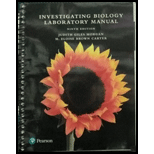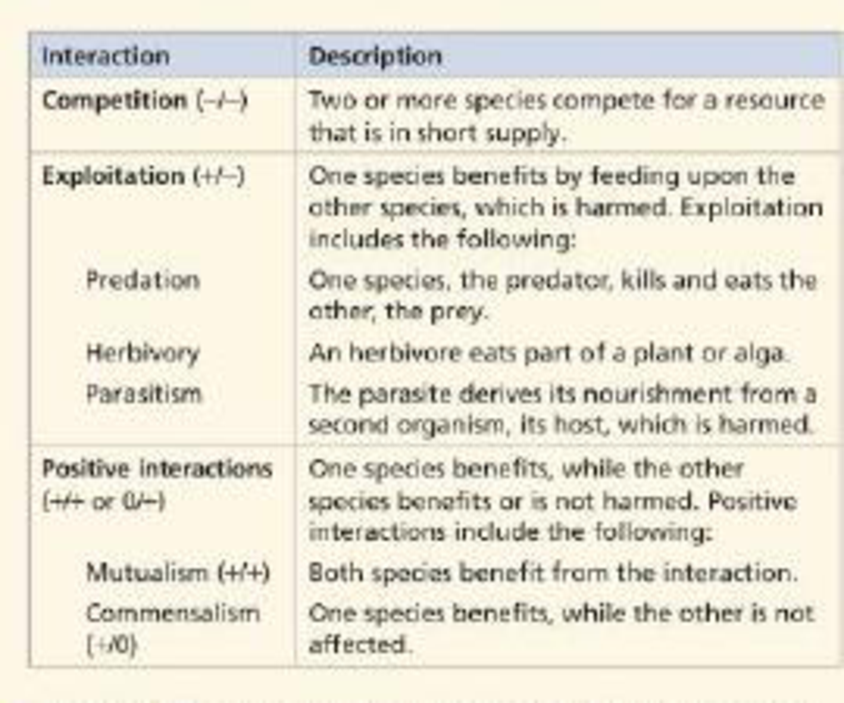
Concept explainers
Interspecific interactions affect the survival and reproduction of the species that engage in them. As shown in the table, these interactions can he grouped into three broad categories: competition, exploitation, and positive interactions.

Competitive exclusion states that two species competing for the same
For each interaction listed in the table, give an example of a pair of species that exhibit the interaction.
To provide: Examples of species involved in different types of interspecific interactions.
Concept introduction: Interspecific interactions refer to the relationship that exists between members of different species of a biological community. It includes commensalism, parasitism, herbivory, predation, competition, and others. These interactions can have either positive or negative impact on the survival of species engaged in the interaction.
Given data: Refer to the table in the concept 54.1 “ Community interactions are classified by whether they help, harm, or have no effect on the species involved”, in the textbook.
Explanation of Solution
The interspecific interactions can be classified into three categories, namely, positive interactions, competition and exploitation.
The positive interaction is a type of interaction in which one species are benefitted and the other may or may not get benefits but is never harmed.
The competition is a type of engagement where both the species are affected (harmed) as they share a common resource (short in supply).
In exploitation, one species get benefit while the other is affected negatively (harmed).
The positive interactions include mutualism and commensalism. On the contrary, exploitation involves predation, parasitism and herbivory.
Interactions along with its examples are tabulated as follows:
| Type of interactions | Examples |
| Competition | Lynx and foxes of Alaska (compete for snowshoe hares) |
| Exploitation | |
| Predation | Lion (predator) and antelope (prey) |
| Herbivory | Rice grasshopper (herbivore) and rice plant (act as food) |
| Parasitism | Plasmodium(parasite) and human (host) |
| Positive interactions | |
| Mutualism | Acacia and ant (both benefit each other) |
| Commensalism | Cattle egrets (get a benefit)and African buffalo (not harmed) |
Want to see more full solutions like this?
Chapter 54 Solutions
Investigating Biology Laboratory Manual (9th Edition)
- Competitive exclusion occurs under the following conditions: a. when fundamental niches overlap and competition is asymmetric b. when realized niches overlap and competition is asymmetric c. when fundamental niches overlap and competition is symmetric d. when realized niches overlap and competition is symmetric e. when competition is excluded because niches do not overlaparrow_forwardWhich of the following statements is correct regarding the competitive exclusion concept? a. multiple species can’t share the exact same niche within a community b. the realized niche of a species is different from its fundamental niche. c. competition within a population results in the success of the best-adapted individuals. d. two species cannot coexist within the same habitat.arrow_forwardWhich of the following statements about the concept of ecological niche is correct? A species' realized niche, may or may not be the same as its fundamental niche The fundamental niche of a species includes biotic and abiotic factors while the realized niche only includes biotic factors A species' fundamental niche is always smaller than its realized niche A niche is the same as a habitatarrow_forward
- Compare and contrast species scale vs. system scale goals for conserving both mutualist biodiversity and mutualist ecosystem function. Give a real world example in which one of these approaches is used for mutualism conservation and explain its strengths and weaknesses with respect to conserving mutualism.arrow_forwardWhat are the possible effects of some ecological threats to the health of an ecosystem? Use the table format provided. You may add rows. Ecological threat effects to ecosystemarrow_forwardAccording to the competitive exclusion principle, two species cannot exist together if they occupy the same niche. Either they diverge their niches so they can coexist or one species will die out.All of the following are consistent with the principle of competitive exclusion EXCEPT Select one: a. Birds and bats both consume flying insects, but birds are active in the day and bats are active at night. b. Two species that share the same niche will exclude other competing species. c. Different bird species forage for insects in different parts of the same tree. d. When two species of Paramecium are grown in the same medium, one strain will eventually eliminate its competitor.arrow_forward
- What roles do competitive exclusion and character displacement play in community structure? Successional sequences are altered by consumers of pioneer species. What ecological features of the pioneer species contribute to this phenomenon? Describe the two key elements of community stability.arrow_forwardThe competitive exclusion principle is best defined as Multiple Choice the competition among individuals of the same species in the same location. the principle that two species that occupy the same niche cannot coexist indefinitely. an interaction between species that enhances the fitness of the exploiting individual while reducing the fitness of the exploited individual. the principle that if an organism allocates energy to one function, such as growth or reproduction, it reduces the amount of energy available to other functions.arrow_forwardThe use of the same limiting resource by two species is called (A) parasitism, (B) competition, (C) mutualism, (D) optimal foraging, (E) character displacement.arrow_forward
- Which of the indices listed would you use ito answer each of the following questions? Answers choices are on the bottom A-G. Has the fish community changed in Alcyon Lake over time? How many mice are in my house? Is the Cannabis I see growing around this property growing in clumps or in a regular pattern Do Bighorn Sheep populations have higher mortality when juveniles or adults? A. Survivorship B. Petersen Index C. Species Richness D. Diversity Index E. Dispersion Index F. Species Turnover G. Importance Valuearrow_forwardA predators can feed on several prey species, but prefer to attack those with the weakest defenses. The same predator may shift to a different prey species that becomes more common or more easily overcome when the previousiy preferred prey had acquired better defenses against the predator. This shifting strategy, known as _____________, results in sequential or alternating bouts of pairwise coevolution between many different species. A. resource shifting B. coevolutionary alternation C. ecological character displacement D. cospeciationarrow_forwardCommunity - Competition. Competition between species on the same trophic tier leads to four potential outcomes, 3 are deterministic (zero sum games where one species goes extinct and the other maximizes their growth to balance at the carrying capacity) and one where both competitors survive, but neither does well. This dynamic suggests that extirpation (local extinction) of populations is a far more likely outcome than co-existence. How, in your opinion, does this affect management policies aimed at increasing biodiversity and proliferation of inter and intra population and interspecies variation. Reason your point of view. Endangered species are defined by low growth rates (r ) and low K (reflecting high demand for resources). What are the implications of both these factors on the outcome of competition scenarios, especially the most common scenario of alternate stable states?arrow_forward
 Biology Today and Tomorrow without Physiology (Mi...BiologyISBN:9781305117396Author:Cecie Starr, Christine Evers, Lisa StarrPublisher:Cengage Learning
Biology Today and Tomorrow without Physiology (Mi...BiologyISBN:9781305117396Author:Cecie Starr, Christine Evers, Lisa StarrPublisher:Cengage Learning
